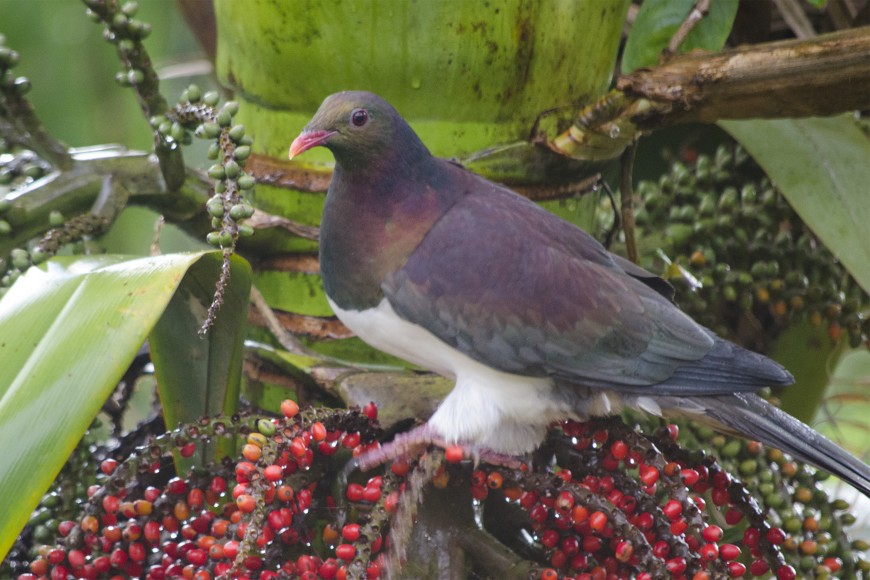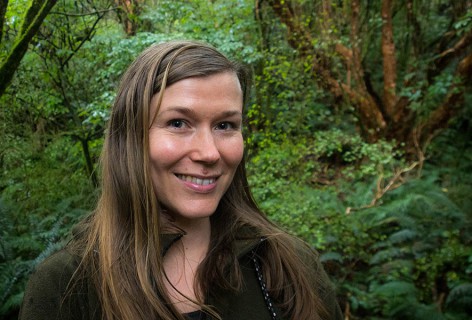Solving the kererū puzzle: predator freedom is only part of the answer

Kererū
First, Anne Schlesselmann collated data from studies that had observed kererū nests. Across the 397 nests monitored in those studies, most failed due to predation by ship rats, possums, or stoats. Kererū only lay one egg per clutch, typically on a precarious platform constructed of loosely woven twigs. Most eggs never had a chance to hatch before they were eaten by ship rats or possums. However, intensive pest control made a difference: at sites where both ship rats and possums were controlled to low numbers, kererū nesting success was substantially improved compared to sites with either no pest control, or where only rats or possums were controlled.
Second, Rachelle Binny analysed a data set of kererū observations collected from 11 sanctuary sites to test the hypothesis that fenced sanctuaries, such as Maungatautari or Orokonui, which have eradicated most pests, would result in increased numbers of kererū being observed. Here the researchers found a puzzle: despite the fact they had good evidence that mammalian predators reduced kererū nesting success, and that pest control improved it, kererū numbers did not always increase in predator-free sanctuaries. Although kererū increased at a few sites, the sanctuaries that had eradicated rats, possums, and stoats did not have obviously better outcomes for kererū than unfenced sanctuaries. It seems that a second factor prevents kererū recovery at some sites after pests have been removed. One possibility is that some sanctuaries only encompass small areas of forest and therefore do not have enough habitat to sustain high numbers of kererū even though pests are controlled. The research demonstrates how important food and forest are to kererū, as well as whether there are pests. Controlling pests in areas with very little suitable kererū habitat is therefore unlikely to result in more kererū.
Third, the team wanted to get a nationwide picture of the factors that influence where kererū are found. Susan Walker analysed the 1969–1979 and 1999–2004 results from the Bird Atlas of New Zealand to see how kererū distribution related to environmental factors such as road density and forest cover. The Bird Atlas collated data collected by birders and citizen scientists over several years in an effort to sample the whole of the country. By comparing records from the 1970s with the later records, the team showed that kererū distribution was closely related to the amount of intact forest available, although kererū also occurred in urban areas, where the wide range of plants probably provides them with more food than in unforested landscapes. The analyses also showed that kererū declined between the two time periods in the South Island, but not in the North Island. The reasons underlying this were unclear, but it could be that kererū manage to hang on in the North Island’s diverse podocarp forests, where pests usually maintain more constant levels, but struggle to cope with the short-lived, yet extreme, irruptions of ship rats and stoats that occur in South Island beech forests. Currently, keen birders are recording bird sightings across the country for the 2019–2024 Bird Atlas of New Zealand. The results from that effort will be important in understanding whether kererū are still declining in parts of New Zealand.
Overall, the results showed that predation by mammalian pests is the primary issue for kererū within large, intact, forests. Controlling possums and ship rats to low densities in these places is likely to increase kererū nesting success and to result in increased numbers of kererū. However, in areas that have suffered significant loss of forest, such as Canterbury and Hawke’s Bay, forest area is likely to be the biggest factor preventing kererū recovery. Kererū are one of the world’s largest pigeons, so they need a diverse range of high-quality food throughout the year to thrive. A combination of both intensive pest control and plentiful kererū kai will be needed before we can begin to restore the massive flocks of the past.

